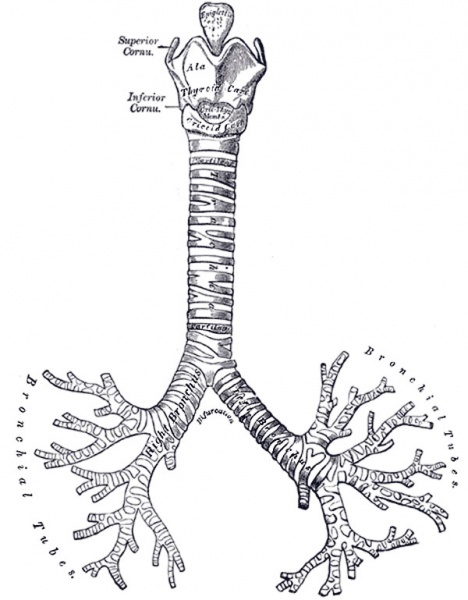File:Gray0961.jpg

Original file (600 × 769 pixels, file size: 66 KB, MIME type: image/jpeg)
Respiratory Tract Cartilages
Respiratory System Development
Front view of cartilages of larynx, trachea, and bronchi.
Trachea
The trachea or windpipe is a cartilaginous and membranous tube, extending from the lower part of the larynx, on a level with the sixth cervical vertebra, to the upper border of the fifth thoracic vertebra, where it divides into the two bronchi, one for each lung.
- The trachea is nearly but not quite cylindrical, being flattened posteriorly
- it measures about 11 cm. in length; its diameter, from side to side, is from 2 to 2.5 cm.
- being always greater in the male than in the female.
- In the child the trachea is smaller, more deeply placed, and more movable than in the adult.
Relations
- Anterior surface of the trachea is convex, and covered:
- in the neck, from above downward, by the isthmus of the thyroid gland; the inferior thyroid veins, the arteria thyroidea ima (when that vessel exists); Sternothyreoideus and Sternohyoideus muscles, the cervical fascia, and, more superficially, by the anastomosing branches between the anterior jugular vein
- in the thorax, it is covered from before backward by the manubrium sterni, the remains of the thymus, the left innominate vein, the aortic arch, the innominate and left common carotid arteries, and the deep cardiac plexus.
- Posteriorly it is in contact with the esophagus.
- Laterally
- in the neck, it is in relation with the common carotid arteries, the right and left lobes of the thyroid gland, the inferior thyroid arteries, and the recurrent nerves
- in the thorax, it lies in the superior mediastinum, and is in relation on the right side with the pleura and right vagus, and near the root of the neck with the innominate artery; on its left side are the left recurrent nerve, the aortic arch, and the left common carotid and subclavian arteries.
Right Bronchus
- (bronchus dexter), wider, shorter, and more vertical in direction than the left, is about 2.5 cm long.
- enters the right lung nearly opposite the fifth thoracic vertebra.
- The azygos vein arches over it from behind; and the right pulmonary artery lies at first below and then in front of it.
- About 2 cm from its commencement it gives off a branch to the upper lobe of the right lung.
- This is termed the eparterial branch of the bronchus, because it arises above the right pulmonary artery.
- The bronchus now passes below the artery, and is known as the hyparterial branch; it divides into two branches for the middle and lower lobes.
Left Bronchus
- (bronchus sinister) is smaller in caliber but longer than the right, being nearly 5 cm long.
- enters the root of the left lung opposite the sixth thoracic vertebra.
- passes beneath the aortic arch, crosses in front of the esophagus, the thoracic duct, and the descending aorta, and has the left pulmonary artery lying at first above, and then in front of it.
- left bronchus has no eparterial branch, and therefore it has been supposed by some that there is no upper lobe to the left lung
- the so-called upper lobe corresponds to the middle lobe of the right lung.
(Text modified from Gray's 1918 Anatomy)
- Gray's Images: Development | Lymphatic | Neural | Vision | Hearing | Somatosensory | Integumentary | Respiratory | Gastrointestinal | Urogenital | Endocrine | Surface Anatomy | iBook | Historic Disclaimer
| Historic Disclaimer - information about historic embryology pages |
|---|
| Pages where the terms "Historic" (textbooks, papers, people, recommendations) appear on this site, and sections within pages where this disclaimer appears, indicate that the content and scientific understanding are specific to the time of publication. This means that while some scientific descriptions are still accurate, the terminology and interpretation of the developmental mechanisms reflect the understanding at the time of original publication and those of the preceding periods, these terms, interpretations and recommendations may not reflect our current scientific understanding. (More? Embryology History | Historic Embryology Papers) |
| iBook - Gray's Embryology | |
|---|---|

|
|
Reference
Gray H. Anatomy of the human body. (1918) Philadelphia: Lea & Febiger.
Cite this page: Hill, M.A. (2024, April 26) Embryology Gray0961.jpg. Retrieved from https://embryology.med.unsw.edu.au/embryology/index.php/File:Gray0961.jpg
- © Dr Mark Hill 2024, UNSW Embryology ISBN: 978 0 7334 2609 4 - UNSW CRICOS Provider Code No. 00098G
File history
Click on a date/time to view the file as it appeared at that time.
| Date/Time | Thumbnail | Dimensions | User | Comment | |
|---|---|---|---|---|---|
| current | 19:07, 21 August 2012 |  | 600 × 769 (66 KB) | Z8600021 (talk | contribs) | |
| 15:04, 24 August 2010 |  | 600 × 769 (63 KB) | S8600021 (talk | contribs) | ==Respiratory Tract Cartilages== Front view of cartilages of larynx, trachea, and bronchi. Category:Gray's 1918 Anatomy Category:Historic Embryology Category:Respiratory Category:Cartilage |
You cannot overwrite this file.
File usage
The following 10 pages use this file:
- 2010 Lecture 10
- ANAT2511 Introduction to Histology
- Anatomy of the Human Body by Henry Gray
- BGDA Practical 7 - Week 5
- Draft 2016
- Lecture - Respiratory Development
- Respiratory System - Upper Respiratory Tract
- Respiratory System Development
- SH Lecture - Respiratory System Development
- SH Practical - Respiratory
